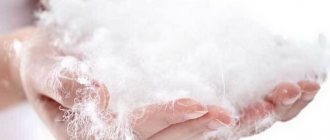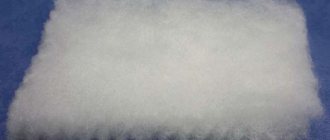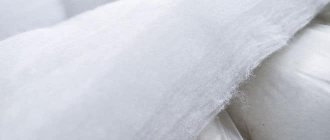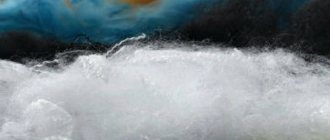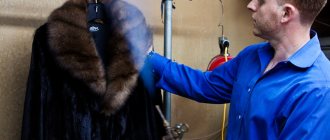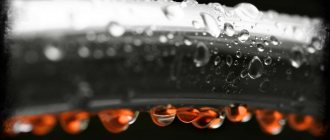The proximity of cold weather makes you think about buying warm clothes. However, this raises the question: what kind of insulation should be used in clothing to provide sufficient warmth without restricting movement?
Isosoft - a modern, inexpensive insulation material that can perfectly retain heat in a small volume. It is the brainchild of the famous Belgian brand Libeltex, which produces filtering nonwoven materials. It should be noted that this company has been doing this for more than 50 years, and, therefore, has vast experience and the trust of customers all over the world. Libeltex production facilities are located not only in Belgium, but also in Sweden and France. Local production of isosoft is carried out only at one plant. This means that the production process is completely coordinated at all stages.
The constant introduction of the most advanced technologies has allowed Libeltex to successfully create a wide variety of types of insulation, both for bedding and outerwear for adults and children.
[ads1]
Main features of isosoft
Isosoft consists of tiny polyester fibers created in such a way that they are better able to retain heat. The fibers are separated by cavities, which also retain heat and ensure that the product retains its shape. Isosoft has a double-sided polymer coating, so the fibers do not spread, but stay in shape.
Many of us have more than once encountered a situation where insulation (for example, padding polyester or feather) “leaked” through the lining. This will not happen with clothes insulated with isosoft. Libeltex is currently in no hurry to reveal the secrets of this property. What is known is that Isosoft insulation is created exclusively from raw materials that fully meet all international quality standards. This confirms that the company has the necessary certificates for the production of materials. Libeltex tries to minimize the use of chemical additives in production.
Special insulation from Belgian manufacturers
Isosoft filler for sleeping bags and blankets
To fill sleeping bags, a special material is made - isosoft 101. The degree of twisting of the fibers is so great that they curl into spirals. Tangles of spirals form spherical structures that perfectly fill space, absorb physical stress from the body of a sleeping person, and take a comfortable shape.
The company produces several other types of specialty products. They have a different fiber composition and are not classified as isosoft.
Advantages of isosoft
Isosoft insulation has a large number of important advantages compared to standard insulation. The outer layer helps retain heat and reliably protects against cold air getting inside.
This leads to the formation of a greenhouse effect inside the clothing. However, you won’t have to sweat, since this insulation is also remarkable in that, thanks to the peculiarities of its structure, it is capable of allowing moisture to escape. When comparing layers of insulation of different types of equal weight, one cannot help but notice that isosoft is four times thinner than synthetic winterizer. But this does not mean that it does not heat as well as padding polyester. On the contrary, isosoft warms much better than synthetic winterizer and other insulation materials, while being several times thinner than them.
Compound
The composition of the described filler is one hundred percent polyester. Sometimes the manufacturer adds silicone to improve performance, but this is extremely rare and must be indicated on the accompanying label. The characteristic ball-shaped structure is easily recognized, palpable even through tissue.
The material is produced by strongly twisting synthetic fibers that are hollow inside, which are additionally sealed on top with high-tech polymers of organosilicon origin. This can significantly improve the thermal insulation properties.
Temperature mode
As a rule, the labels of clothes that contain various synthetic insulation materials indicate the density level of this insulation per 1 cm3.
For example, it may say Isosoft 260 or 130 grams. Approximate calculation of density level indicators for different weather conditions:
- Very cold winter - from 200 to 330 grams. At temperatures from +5 to -25° - with insulation with a density of 330/250/200 grams, no tucking is required; if the temperature outside is lower, then it is necessary to wear additional clothes.
- Warm winter, cold autumn-spring - from 100 to 150 grams. At temperatures from 0 to -15° - with insulation with a density of 130-150 and 120 grams without prying, and if the temperature is lower - with prying.
- Warm autumn-spring – from 40 to 70 grams. If the temperature outside is from +10 to 0°, then you can without additional insulation, at a temperature level lower than -15° you need to insulate yourself, and at a temperature from 0 to -15° you need to additionally put something warm under your pants - tights or leggings.
[ads3]
Types of widely used insulation from Belgian manufacturers
The company produces 3 main types of insulation materials for a wide range of applications.
- Isosoft 103 is made from the finest fibers thermally bonded to each other. Plastic, soft material with double-sided polymer processing has a density ranging from 25 g/m2 to 200 g/m2 (indicated in the articles). The thickness of the insulation falls within the range from 3 mm to 25 mm. Products with such insulation must be quilted.
- Material with a density from 20 g/m2 to 80 g/m2 is suitable for spring and autumn clothing. The air temperature should not be below 0°C.
- Insulation materials with a density of up to 150 g/m2 are intended for frosts up to 10°C.
- Material with a density of up to 180 g/m2 is suitable for temperatures down to minus 15°C.
- If the specified insulation density is 200-300 g/m2, clothing can be worn at minus 30°C.
In the Isosoft 103 line, the maximum density is 200 g/m2. Consequently, from the group of this marking only insulation with maximum density is suitable for severe frosts.
- Isosoft 34 is made of siliconized hollow polyester fibers, thermally bonded. The material thickness of this marking ranges from 4 mm to 15 mm. The insulation on both sides is additionally treated with polymers. Density range - from 40 g/m2 to 200 g/m2. In products with insulation density up to 100 g/m2, it is not necessary to quilt it.
- Isosoft 304 consists of siliconized polyester fibers, which are thermally and polymer cross-linked. The range of densities is from 40 g/m2 to 250 g/m2. The thickness of the canvas ranges from 6 mm to 22 mm. The insulation can be freely located in long and short jackets and trousers. In a coat, it must be quilted.
Comparison with closest competitors
What is better suited for the conditions of the Russian winter - down, Thinsulate or Isosoft?
Each insulation has both its strong and weak points. The specific gravity of Thinsulate is slightly less than that of other insulation materials, but it is extremely susceptible to deformation. Natural down is a rather expensive pleasure, which usually costs three times more. In addition, natural fluff is not very friendly with water - when wet processed it is extremely unstable and after it completely loses its already insignificant thermal insulation properties.
Isosoft is a completely different matter. Even when wet, it retains heat perfectly, so if you wear a jacket with isosoft, you don’t have to be afraid of getting caught in wet snow or rain. This is of great importance for a modern person who leads an active lifestyle and does not want to limit his freedom of movement due to the vagaries of the weather.
Thinsulate is made only from environmentally friendly materials. Its quality and safety are confirmed by the European Quality Certificate. This certainly says a lot. The temperature level during cleaning and dry cleaning should not exceed 40°.
Thinsulate in composition and many basic parameters does not differ from isosoft. So it’s quite difficult to say exactly why the latter is better than the former. The advantages of these materials speak for themselves, so when choosing a material it is better to be guided by your own opinion as to what exactly you should wear in this or that weather. However, if we are talking about clothes for a child, then you cannot find a better and warmer filler than Isosoft.
Insulation properties
The filler has many advantages, which are determined by the composition and structure of the material.
- Thermal insulation - the material retains heat well. In clothes with such insulation, even in thirty-degree frost, a person feels warm and comfortable.
- Air permeability - the fabric “breathes” due to the air spaces between the fibers. Isosoft not only warms the body, but also removes natural moisture through specific pores.
- Weight - light, almost airy insulation is much lighter than padding polyester and its “brothers”. Outerwear made from this material is lightweight, lightweight and comfortable.
- Hypoallergenic - the fabric does not cause allergies even in people prone to such reactions.
- Drying speed – the insulation dries quickly after wet treatment.
- Care - products with isosoft do not require special care. They are easy to wash in a machine and by hand, dry quickly and do not require ironing.
- Storage - things with this insulation are easy to store. They can be rolled into a tight roll and placed on a cabinet shelf without fear that the filler will break or form clumps. The product will quickly restore its original shape when it comes time to remove it from the cabinet.
According to customer reviews, isosoft is superior in all characteristics to the synthetic winterizer, popular in our country. But not everyone can buy it because of the high cost.
How to buy high-quality clothes with isosoft insulation?
To purchase high-quality clothes with isosoft, you should definitely know the following selection criteria:
- Buy clothes only from well-established manufacturers, as they value their reputation very much and therefore pay very close attention to the quality of the clothes they make.
- Surf the Internet and carefully read customer reviews.
- Before buying, look at the tag inside the clothing (often unscrupulous, profit-obsessed sellers endow their product with properties that are absolutely not inherent in it in order to force the buyer to buy it).
Advantages and disadvantages
- The remarkable qualities of winter or demi-season clothing are largely determined by the porous, air-filled structure of Isosoft.
- Excellent thermal protection;
- Softness and elasticity;
- High breathability;
- Light weight;
- Small thickness;
- Quick recovery of shape after compression;
- Retains shape after many washes;
- Fast drying.
Isosoft's double-sided polymer coating prevents fibers from rolling and migrating. Combination with many fabrics increases wear resistance. Polyester fibers and glue-free production technology explain the environmental friendliness and hypoallergenic nature of the material. Organisms harmful to humans - dust mites, putrefactive fungi and pathogenic bacteria - do not live in it. Warm clothes with Isosoft are recommended for those whose profession involves exposure to frost, athletes, tourists, and people prone to allergies.
Unfortunately, the material produced in Belgium has one significant drawback - the price. Delivery, customs clearance and high costs for widespread advertising make Isosoft a very expensive product.
Read about: features and scope of application of padding polyester
How to care for clothes?
Clothes insulated with isosoft can be dry cleaned. It can also be easily washed in a washing machine at a temperature of 30 to 40° Celsius or by hand. In this case, you should only use detergents that do not contain chlorine.
In order for the isosoft to dry quickly, it must be placed in a vertical position. It is enough for the water to drain completely and it is practically dry. Clothing with isosoft should be stored not folded, but rolled up. Following these simple rules will allow you to wear clothes for many seasons.
So that the item lasts for a long time
Insulated items require periodic maintenance. They can be dry cleaned or machine washed at 30°C. True, this should be done without soaking and using bleaching agents. To better preserve their shape, it is recommended to wash items with insulation separately from others, and fasten all zippers and Velcro before washing. You cannot dry items in a drum or on heating devices. Dry washed items vertically. Isosoft is not ironed.
Among synthetic insulation materials, the product of the Belgian company Libeltex occupies a special place. The Isosoft trademark is a guarantee of impeccable European quality. Products insulated with this material will make you forget about frost and bad weather. They will reliably warm your baby, and will lead you to sports records or peaks in your profession.
© 2022 textiletrend.ru
Retail price for Isosoft-Isosoft 34/304
| Meters in 1 roll | Width | Thickness | Density | Price for 1 meter | Minimum purchase |
| 120 meters | 1.5 meters | ~ 0.6 cm. | 60 g/m2 | 220 rub./meter | 5 meters |
| 90 meters | 1.5 meters | ~ 0.8 cm. | 80 g/m2 | 270 rub./meter | 5 meters |
| 75 meters | 1.5 meters | ~ 1 cm. | 100 g/m2 | 350 rub./meter | 3 meters |
| 60 meters | 1.5 meters | ~ 1.5 cm. | 150 g/m2 | 450 rub./meter | 3 meters |
| 50 meters | 1.5 meters | ~ 2 cm. | 200 g/m2 | 550 rub./meter | 3 meters |
| 40 meters | 1.5 meters | ~ 2.5 cm. | 250 g/m2 | 700 rub./meter | 3 meters |
| 30 meters | 1.5 meters | ~ 3 cm. | 280 g/m2 | 800 rub./meter | 3 meters |
Application area
Typically, isosoft insulation is used for its intended purpose: it makes outerwear warmer and more comfortable. It retains heat perfectly without weighing the item down. Children feel comfortable, move freely, without experiencing any constraint.
Adults, wearing such suits, jackets or coats, can lead an active lifestyle, engage in winter sports, without feeling any pressure or heaviness, without sweating even during intense physical exertion.
Isosoft filler is often used as a lining for sleeping bags. It does not allow the cold to pass through, reliably warming tourists, military personnel or people of special professions. But modern material is not only suitable for clothing.
It is often found in hats, insulated mittens, and various overalls for polar explorers, industrial climbers, and explorers of northern latitudes. In addition, Isosoft is used as a filler for bed linen, mattresses, and pillows.
How to determine if a child is cold?
First of all, when buying clothes, you can see that the amount of filling in a jacket and trousers can differ by almost two times. In addition, there is usually very little insulation in the sleeves compared to the body, since they are most often in motion and hardly freeze. You should also pay attention that the amount of filler in outerwear is distributed equally, whether it’s an adult set or a child’s set.
Any mother can independently determine how warm 80 g of insulation is and what temperature it is designed for. And to make sure that her child is not cold, you need to touch his hands, nose, cheeks and back. They should be at room temperature. Parts of the body that are too hot may indicate overheating. By the way, the problem of hypothermia is easily solved with the help of thermal underwear.
Wholesale price for Isosoft-Isosoft 34/304
| Meters in 1 roll | Width | Thickness | Density | Price for 1 roll | Minimum purchase |
| 120 meters | 1.5 meters | ~ 0.6 cm. | 60 g/m2 | 18500 rub. | 1 roll |
| 90 meters | 1.5 meters | ~ 0.8 cm. | 80 g/m2 | 16500 rub. | 1 roll |
| 75 meters | 1.5 meters | ~ 1 cm. | 100 g/m2 | 16500 rub. | 1 roll |
| 60 meters | 1.5 meters | ~ 1.5 cm. | 150 g/m2 | 17800 rub. | 1 roll |
| 50 meters | 1.5 meters | ~ 2 cm. | 200 g/m2 | 18500 rub. | 1 roll |
| 40 meters | 1.5 meters | ~ 2.5 cm. | 250 g/m2 | 19500 rub. | 1 roll |
| 30 meters | 1.5 meters | ~ 3 cm. | 280 g/m2 | 16500 rub. | 1 roll |
Synthetic winterizer for insulating outerwear
Sintepon is an artificial insulation made from polyester fibers. It is produced in two ways: adhesive and hot-melt. The difference in the result is obvious.
Adhesive padding polyester is a type of insulation in which polyester fibers are laid in layers and glued well together. The main advantage of this filler is its minimal price. Otherwise, this material has only drawbacks. It is not environmentally friendly, has low air conductivity and does not retain heat well.
Hot-melt synthetic padding also consists of polyester fibers, but in such insulation they are not glued together, but are connected to each other using special silicone needles. Hot-melt adhesive filler is environmentally friendly and hypoallergenic, does not deform over time and has good wear resistance. It has different thicknesses or densities and is designed for different temperatures. What are the characteristics of insulation (density 80)? This issue needs to be considered in more detail.
Advantages and disadvantages of natural insulation materials
Despite the large number of synthetic fillers, outerwear insulated with down and feathers still remains in demand. The following attracts buyers:
- low specific gravity;
- small volume;
- high thermal insulation characteristics;
- environmental friendliness of the material;
- wear resistance, durability.
Meanwhile, down insulation also has significant disadvantages:
- high probability of allergic reactions;
- an ideal breeding ground for dust mites;
- labor-intensive care;
- low heat-regulating properties.
It is this last drawback that plays a decisive role when choosing clothes with natural insulation. At a temperature of -15 degrees, an active person will feel very hot in a jacket filled with down, while synthetics in this case provide a more favorable microclimate inside.
